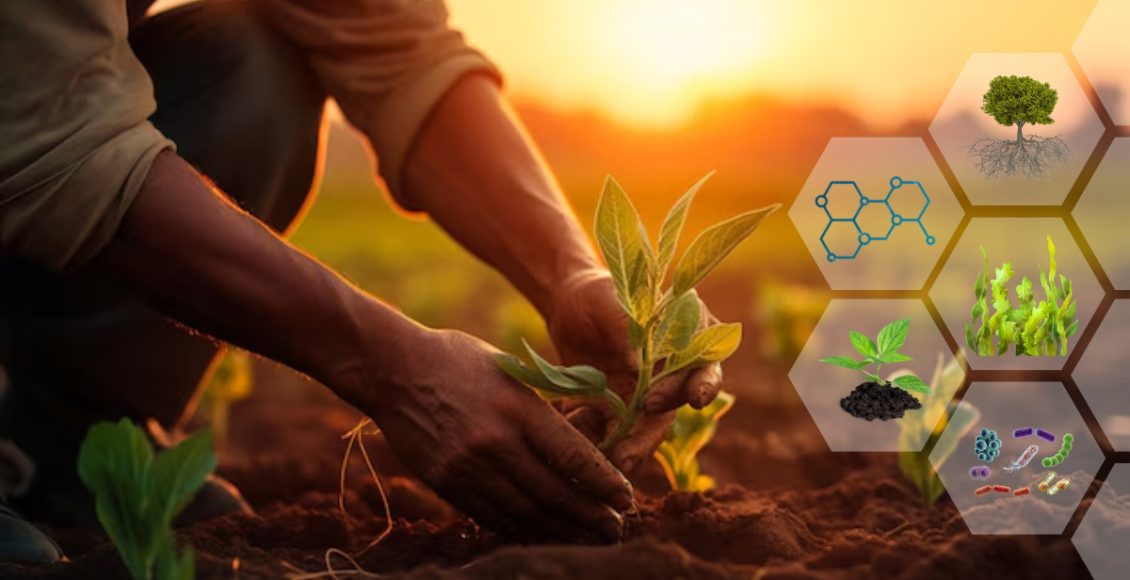
Biostimulants – The Alchemy of Modern and Future Agriculture Technology
The agricultural sector faces the challenges of increasing productivity to feed the growing population, improving resource use efficiency, and reducing environmental impact. Chemical fertilizers and pesticides are crucial for enhancing yields and ensuring consistent productivity under both optimal and suboptimal conditions. The use of biostimulants to stimulate plant growth and provide nutrition is gaining popularity globally.
Farming Practices in India
In India, agriculture is the primary livelihood source for about 58% of the population. Indian agriculture market mainly relies on conventional farming practices were in the fertilizers and pesticides have played a vital role in boosting agricultural production. The need to enhance productivity to cater to the food demand of the growing population has been the key factor driving the use and application of agrochemicals. Despite this, there is a growing concern about the negative effect of agrochemical that harms the consumers either directly or indirectly as traces of residues have been reported to cause serious health issues upon time and the deleterious effect of spurious chemicals that got leached into the ground water table.
When it comes to increasing crop yields in an environmentally friendly and sustainable way, an increasing number of Indian farmers are turning to organic farming practices. Particularly, biostimulants based technology have become an integral part of organic farming and it has been integrated into the National Programme for Organic Farming by the Indian government. In India according to organic certification data under National Programme for Organic Production (NPOP) 2022-23 survey the total organic cultivated area was around 5.4 million Ha including cultivated area in conversion. Also, the commercial production of organic agricultural products was 2.9 million MT [1]. Biostimulants based technology represent a sustainable, efficient or complement to their synthetic counterparts (i.e., agrochemicals industry).
Biostimulants Market in India
The Indian biostimulants market size is estimated at USD 188.19 million in 2024 and is expected to reach USD 310.14  million by 2029, growing at a CAGR of 10.51% during the forecast period (2024-2029) [2]. According to NPOP, Madhya Pradesh tops the table owing to the area under organic certification of about 1.5 million Ha with a total production rate of 0.8 million MT for the year 2022-2023.
million by 2029, growing at a CAGR of 10.51% during the forecast period (2024-2029) [2]. According to NPOP, Madhya Pradesh tops the table owing to the area under organic certification of about 1.5 million Ha with a total production rate of 0.8 million MT for the year 2022-2023.
As per the data generated by 2022, among the crop segment, row crops (wheat, paddy, sorghum, millet, barley, and maize) accounted for 86.2% of the biostimulants market value. As approximately 82.3% area under organic cultivation was contributed by row crops. Cash crops and horticultural crops account for 11.2% and 2.6% of the biostimulants market, respectively. Seaweed extract based biostimulants have the largest Indian market share, accounting for 37.4%, with a market value of USD 57.2 million [2].
Government Policies in Boosting Organic Farming Practices
The Indian government is promoting the production of organic crops, fruits, and vegetables through various schemes, like National Horticulture Mission, Horticulture Mission for North-East and Himalayan States, Rashtriya Krishi Vikas Yojana, National Project on Management of Soil Health and Fertility, National Project on Organic Farming, Network Project on Organic Farming under Indian Council of Agricultural Research, and Paramparagat Krishi Vikas Yojana [3].
Regulations and Guidelines on Biostimulants
As per the guidelines, biostimulants will have to be first registered provisionally and to prove efficacy before hitting the market. The present market guidelines for different agricultural inputs like fertilizer/pesticides/biostimulants are aligned with the national regulatory provisions of Central Insecticide Board and Registration Committee (CIB&RC), Ministry of Agriculture and Farmers Welfare, Department of Agriculture, Co-operation & Farmers Welfare issued the Fertilizer (Inorganic, Organic or Mixed) Control Order (FCO), 1985 under the Essential Commodities Act, 1955 [4]. The FCO sets down the criteria for substances to be qualified for the use as a biostimulants in soil. They regulate the trade, quality, price, and distribution across the country.
The biostimulant products can be sold/imported only after provisional registration or inclusion in the “Schedule VI” (Proper labelling with manufacturers details, ingredients, and expiry date as per applicable regulation of packaging and labelling. The regulation was set with high standards for product safety requirements, with limits on heavy metal contamination and permissible limit for pesticides). Followed by permanent registration by producing the trade documents for the years suggested by the regulatory authorities along with the chemical profile, bio efficacy and toxicology report [4]. Recently, the Government of India has released an amendment to the FCO 1985 hat has raised the permissible limit of pesticides and allowed the exemption of certain low risk biostimulants products from submitting the full toxicity data (Gazette ID-CG-DL-E-09052024-254121) [5].
Challenges and The Way Forward
The new fertilizer laws on biostimulants in recent past have streamlined the industry which were highly unorganized before. Certain major constraints the biostimulants sector facing is the transparency of the processing time and the lack of uniformity in standardized method of analysis of the product of different companies to meet the specifications, as this creates ambiguity that hinder market entry, limiting investment in biostimulants sector.
Allocation of a significant share of the budget expenditure, encouraging R&D with new formulations, provides enormous growth opportunities for quality products sustainably improving crop productivity, soil health, and strengthen farmers economically. Research on new generation biostimulants product in combination with pesticides and fertilizers with proper consideration and scientific expertise opens doors to innovative products with novel combinations and employing targeted delivery system enables a tailored solution for the industries in this sector. Collaborative efforts between research institutes and industrial R&D department could push the boundaries of biostimulants technology further. Data driven decision making using artificial intelligence (AI) platform could open new windows to develop an effective, sustainable solutions that empowers the biostimulants industry.
References
- https://apeda.gov.in/apedawebsite/organic/data.htm
- https://www.mordorintelligence.com/industry-reports/india-biostimulants-market
- Yadav, M. (2017). Towards a healthier nation: organic farming and government policies in India. International Journal for Advance Research and Development, 2(5), 153-159.
- https://enterclimate.com/blog/biostimulant-registration/
- https://egazette.gov.in/(S(syptemvaarzhut1fpg43zz3z))/default.aspx
Author:

Sr. Consultant – Life Science Advisory
Connect with Author at: E-mail agribusiness@sathguru.com
 Grow Beyond
Grow Beyond 

